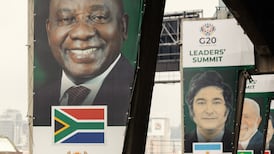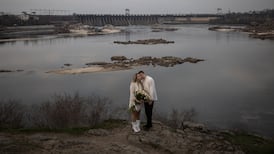Some 60.4 million Germans are called to elect a new government on September 26th and all polls suggest it will be a tight race.
Chancellor Angela Merkel is standing down after four terms and her Christian Democratic Union (CDU) is struggling without her. The centre-right party is in second place, trailing by 3-5 percentage points. Recent polls show it closing the lead with the front-runner, the centre-left Social Democratic Party (SPD).
With the outcome impossible to predict, the only certainty is that, given ongoing fragmentation of the political landscape, Germany is likely to get its first three-party coalition. Here are the main parties up for election, and their post-election options:
Christian Democratic Union (CDU)-Christian Social Union (CSU)
The CDU is a centre-right party that lives to rule – governing in Bonn, then Berlin, for all but 20 years since 1949. It has given Germany chancellors such as Konrad Adenauer, postwar West Germany's founding father, and Helmut Kohl, chancellor of German unity. In 2018, Angela Merkel stood down as party leader after 18 years. Armin Laschet, the party's second leader since then, was nominated lead candidate in April and, after a brief surge, has been on a downhill run ever since. A lack of political focus and a series of gaffes – in particular being caught on camera laughing in a flood-devastated town – have undermined his credibility. In the election – and in parliament – the CDU forms a centre-right "union" with the CSU, which only runs in Bavaria and has ruled the state almost uninterrupted since 1949.
Social Democratic Party (SPD)
The centre-left SPD is Germany's oldest party, founded in 1863. After legendary chancellors Willy Brandt and Helmut Schmidt, it returned to power with Gerhard Schröder for seven years until 2005. Internal pushback at economic and social reforms split the party and saw it lose the chancellery. In the years since it has served three times as junior partner in a grand coalition with the CDU, complicating party efforts to reconcile itself with the Schröder-era reforms. After years of infighting, the party's leftist and centrist wings have united around Olaf Scholz, outgoing finance minister and a centrist politician presenting a leftist programme.
Free Democratic Party (FPD)
Germany's pro-business liberals are likely to be kingmakers after the election, a role they played for decades in postwar politics, alternately with the CDU and SPD, and most recently with Merkel for four years until 2017. Traditionally the party of free market economics and guardian civil rights, the FDP has struggled to maintain its profile under a series of strong-willed leaders. The latest, Christian Lindner, pulled out of coalition talks with the CDU and Greens in 2017, insisting it was "better not to govern than to govern badly". The FDP's strident criticism of pandemic restrictions rebuilt credibility and trust with its traditional business base.
Greens
After an early surge in polls to first place, the Greens have slumped somewhat but, in all likelihood, are heading back to power for the first time since 2005. Their lead candidate Annalena Baerbock has regained momentum after early campaign gaffes. But aged just 40, and with no executive experience, many Germans fear she is not a political heavyweight. After years with a reputation as the "ban" party, the Greens have reframed their green message in a more positive light. They hope recent devastating floods in western German will concentrate voter minds on the need for a climate component to the next coalition.
Alternative für Deutschland (AfD)
Born in the euro crisis as an anti-bailout protest party, the AfD gained ground during the 2015-2016 refugee crisis. Four years ago it entered the Bundestag for the first time as the largest opposition party, promising to "hunt down" the Merkel administration. Its political offering runs the gamut from right-wing conservatism to far-right nationalism, stridently xenophobic and with climate and Covid-19 scepticism in the mix. The party is wracked by infighting and has struggled in polls to reach its previous election result, but hopes for a strong result in eastern regions.
Die Linke (The Left)
Germany's hard-left party proposes a radical shift in domestic and foreign policy. It is the political successor to East Germany's ruling communist party (SED), supplemented by SPD members who broke away in protest at Schröder-era reforms. Effectively it is two parties: a more pragmatic wing in eastern Germany, with considerable state government experience, and a western German fundamentalist wing. Its election demands include a higher minimum wage, pensions and welfare payments, largely financed by a wealth tax. Its foreign policy demands – in particular replacing Nato with a global security system including Russia – are likely to place it at the fringes of any post-election coalition talks.
COALITION OPTIONS -
“Traffic-light” coalition: SPD-Green-FDP
In the final days before the election this is emerging as the most likely option. With the (red) SPD candidate Olaf Scholz as chancellor, the “traffic light” would need to balance SPD campaign promises – a €12 minimum wage and rent controls – with a Green climate transformation plan for transport and industry. But the (yellow) FDP is opposed to both welfare or climate measures that burden companies. Above all it opposes SPD-Green proposals for tax increases for top earners and a wealth tax.
“Jamaica”: CDU/CSU-Green-FDP
This coalition, named after the island nation, is the most likely option if the (black) CDU finishes first. It almost came about in 2017 until the FDP walked out of advanced coalition talks. Unlike the traffic light, this coalition would put the Greens on the back foot with their climate ambitions. But CDU leader Laschet has signalled his desire for a far-reaching political investment that allows German companies make a “green leap” and become leaders in sustainable, transformative climate-friendly business and technology. Tax relief to lower earners would be likely, but hikes for the rich would be off the table.
“R2G” (SPD-Green-Linke [Left])
This option is unlikely to happen but remains on the table as a coalition poker chip for the SPD. The Linke is the legal successor to East Germany’s communist ruling party and, despite ruling in state coalitions (including currently in Berlin) has never been part of a federal administration. Chief barriers to this include its pro-Russia outlook, opposition to Nato and doubts about Germany’s EU membership. The Linke insists it is ready for office; Scholz has said its Nato-EU policies make that unlikely – but not impossible.
“Kenya” (CDU/CSU-SPD-Green)
Arithmetically a possibility, if CDU and SPD fall below a majority. This would add the Greens to the existing grand coalition, pushing climate policy and giving momentum to the SPD’s social justice platform.
Grand coalition (CDU/CSU-SPD)
The coalition option that dare not speak its name. After three such governments since 2005, no one in Berlin wants another. But never say never . . .
ELECTORAL SYSTEM -
Germany has 299 constituencies and a proportional system that gives each voter two votes: one for a party list, another for a direct, local candidate. The Bundestag has 598 seats with half (299) reserved for list candidates, the other half for direct candidates.
If the party gets more direct candidates in a constituency than it is entitled to (linked to its share of the list vote), the direct MPs take their seat anyway in addition to the 299 direct MP allocation. This creates additional seats and has swollen successive parliaments – 709 in the outgoing Bundestag.
Repeated attempts to correct the phenomenon have failed and this incoming parliament is forecast to have well over 800 – possibly even 900 – seats. That would make it the world's biggest parliament – after China.











